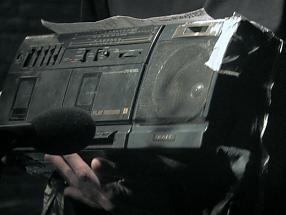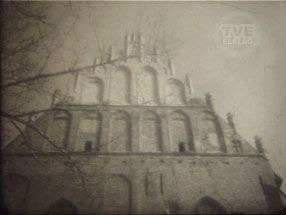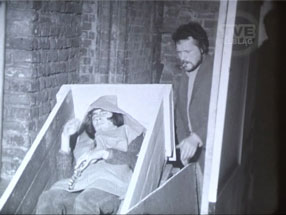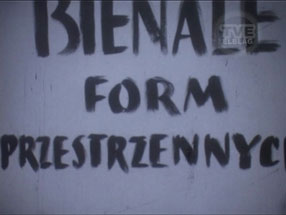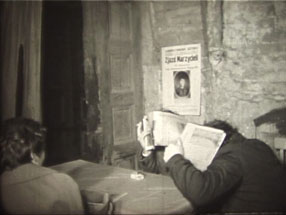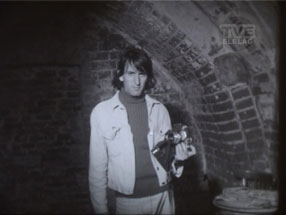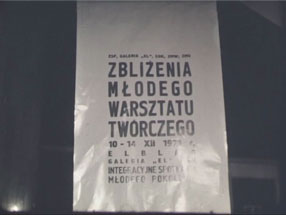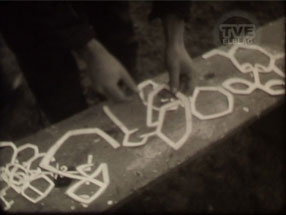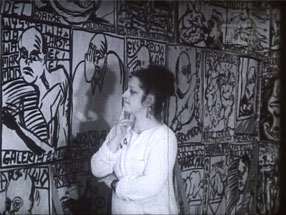Biennial of Spatial Forms in Elbląg was a cyclic artistic event taking place between 1965 and 1973, which led to enriching the public space of the city with several dozens of abstract metal sculptures. The initiative came from the EL Gallery, run by Gerard Kwiatkowski, in cooperation with Karol Świerczewski Mechanical “Works Zamech”.
People of Elbląg are watching the installation of the 9-metre spatial form by Jerzy Langiewicz with characteristic “aerials” in the frame of the 1st Biennial of Spatial Forms in 1965, in the vicinity of today's City Office near Ratuszowa St. In the 1980s the form was transferred to Kajka Park. View of the 8-metre high, unpreserved sculpture by Josef Wagner – part of collective project by artists from Czechoslovakia in the ruins of the Corpus Christi church in 1965. The sculpture adopted the form of a high column made of cubic modules posed on a plinth in a destroyed niche of the church. 2.5-metre high spatial form by Jan Wagner with characteristic hooked, slanted arms. Created in 1965 in the frame of a joint project of artists from Czechoslovakia, it was moved in the 1990s on the crossroads of Robotnicza and Teatralna Streets.
Sculpture by Julian Boss-Goslawski in a four-leaf form with pointed vertical elements protruding from within. The form of 12.5 metres in height (the highest of Elbląg’s spatial forms) was built in 1965 in the vicinity of Stary Rynek St. The 4.5 metre high spatial form by Henryk Stazewski was made in 1965 in the square between Słowiański Sq and the Old Town. The sculpture is composed of thin square plaques with concave sides fixed on rods to the vertical wall rising arch-wise. Another look at Jerzy Langiewicz's spatial form, seen from beneath. Sculpture by Krystyn Zieliński from 1965 in the form of a circle composed of pipes cut along. The 3-metre high form is situated at the crossroads of Giermków and Szkolna Streets.
Spatial form by Gerard Kwiatkowski (dimensions: 2 x 4 x 3 m), composed of a number of pyramids. A glimpse of Adam Marczyński’s kinetic form in Kajka Park. The 7-metre high composition comprises rectangular coffers with fixed flaps moved by the force of the wind. General view of the area of Elbląg from Chrobry Mountain alongside the sculpture Destruction situated on top, built in 1969 in the frame of the 2nd Biennial of Spatial Forms, unpreserved until today. The 7-metre high composition consists of scrap metal of irregular shapes and, according to the artist's concept, it was to become subject to progressive degradation caused by the passage of time and atmospheric conditions.
A glimpse of a part of the 3.5-metre high spatial form by Jerzy Krechowicz from 1965, located next to the entrance gate to the Gallery EL's yard (originally at the back of the ruins of a former cloister) – the only sculpture realised during the 1st Biennial to merge metal and wooden elements. The pipe narrowing towards the top, with a ripped circle on top is the 7-metre high form by Edward Krasiński made in 1965 in the south-western part of Gallery EL's yard. Jerzy Jarnuszkiewicz's form entitled Witacz or Kompozycja drogowskazowa, built in 1965 on the crossroads of Rycerska St., Sopocka St. and Tysiaclecia Av. The 8-metre composition fixed to the support with steel ropes comprises flat metal sheets fixed parallelly, at sharp angles to the frame
References: Spatial forms in Elbląg. Guidebook, Jarosław Denisiuk (ed.), Elbląg 2006.
(ŁM)
Year: 1965
Duration: 2'03"
Language: no sound
Place: EL Gallery, Elbląg
Source: 16 mm
© Muzeum Archeologiczno-Historyczne w Elblągu
Acquisition: deposit
Ownership form: deposit
